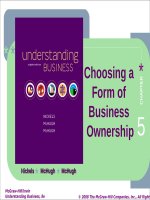Understanding business 11th by mchugh nickels chap010
Bạn đang xem bản rút gọn của tài liệu. Xem và tải ngay bản đầy đủ của tài liệu tại đây (1.38 MB, 61 trang )
CHAPTER 10
Motivating
Employees
McGraw-Hill/Irwin
Copyright © 2015 by the McGraw-Hill Companies, Inc. All rights reserved.
LEARNING OBJECTIVES
1. Explain Taylor’s theory of scientific management.
2. Describe the Hawthorne studies and their
significance to management.
3. Identify the levels of Maslow’s hierarchy of needs
and apply them to employee motivation.
4. Distinguish between the motivators and hygiene
factors identified by Herzberg.
5. Differentiate among Theory X, Theory Y, and Theory
Z.
10-2
LEARNING OBJECTIVES
6. Explain the key principles of goal-setting,
expectancy, reinforcement, and equity theories.
7. Show how managers put motivation theories into
action through such strategies as job enrichment,
open communication, and job recognition.
8. Show how managers personalize motivation
strategies to appeal to employees across the globe
and across generations.
10-3
DAVID NOVAK
Yum Brands
• One of the largest food
companies, a restaurant is
opened every 14 hours.
• Novak stresses the
importance of his team of
employees worldwide.
• He is committed to growing
the company by boosting
employee morale.
10-4
NAME that COMPANY
Job enlargement combines a series of tasks into
one challenging and interesting assignment. This
home appliance manufacturer redesigned its
washing machine production process so that
employees could assemble an entire water pump
instead of just adding one part.
Name that company!
10-5
INTRINSIC REWARDS
• Intrinsic Rewards -- Personal satisfaction you feel
when you perform well and complete goals.
• Examples of
Intrinsic Rewards:
- Pride in your
performance
- Sense of
achievement
10-6
EXTRINSIC REWARDS
• Extrinsic Rewards -- Something given as a
recognition of good work.
• Kinds of Extrinsic Rewards:
- Pay Raises
- Promotions
- Awards
10-7
FRINGE BENEFITS
Perks Offered to Employees at Top 50 Employers
Source: Bloomberg BusinessWeek, www.businessweek.com, accessed November 2014.
10-8
TAYLOR’S SCIENTIFIC
MANAGEMENT
LO 10-1
• Scientific Management -- Studying workers to find
the most efficient ways of doing things and then
teaching people those techniques.
• Three Key Elements to Increase Productivity
1. Time
2. Methods of Work
3. Rules of Work
10-9
TAYLOR’S FOUR KEY
PRINCIPLES
LO 10-1
1. Study how a job is performed.
• Gather time & motion information.
• Check different methods.
2. Codify the best method into rules.
3. Choose workers whose skill matches the rules.
4. Establish a fair level of performance and pay.
10-10
TIME-MOTION STUDIES
LO 10-1
• Time-Motion Studies -- Studies of which tasks
must be performed to complete a job and the time
needed to do each task.
• Led to the development of the Principle of
Motion Economy -- Every job can be broken down
into a series of elementary motions; developed by
Frank and Lillian Gilbreth.
10-11
ARE YOU STRESSED?
LO 10-1
Warnings of Employee Stress
• Negative attitudes about work
• Drops in productivity
• Chronic lateness
• Absenteeism
• Careless with details
• Unable to work with others
• Withdrawal from co-workers
• Easily upset or angered
10-12
TAYLOR and UPS
LO 10-1
• UPS drivers work under strict rules and work
requirements.
• How to get out of their trucks:
- Right foot first
• How fast to walk:
- 3 ft per second
• How to hold their keys:
- Teeth up, third finger
10-13
HAWTHORNE STUDIES:
PURPOSE AND RESULTS
LO 10-2
• Researchers studied worker efficiency under
different levels of light.
• Productivity increased regardless of light
condition.
• Researchers decided it was
a human or psychological
factor at play.
• Hawthorne Effect -- People
act differently when they know
they are being studied.
10-14
MASLOW’S
THEORY of MOTIVATION
LO 10-3
• Hierarchy of Needs -- Theory of motivation
based on unmet human needs from basic
physiological needs to safety, social and esteem
needs to self-actualization needs.
• Needs that have already been met do not
motivate.
• If a need is filled, another higher-level need
emerges.
10-15
MASLOW’S
HIERARCHY of NEEDS
LO 10-2
10-16
HERZBERG’S
MOTIVATING FACTORS
LO 10-4
• Herzberg’s research centered on two questions:
- What factors controlled by managers are most
effective in increasing worker motivation?
- How do workers rank job-related factors in order
of importance related to motivation?
10-17
JOB CONTENT
LO 10-4
• Herzberg found job content
factors were most important
to workers – workers like to
feel they contribute to the
company.
• Motivators -- Job factors that
cause employees to be
productive and that give them
satisfaction.
10-18
JOB ENVIRONMENT
LO 10-4
• Job environment factors maintained satisfaction,
but did not motivate employees.
• Hygiene Factors -- Job
factors that can cause
dissatisfaction if missing but
that do not necessarily
motivate employees if
increased.
10-19
HERZBERG’S MOTIVATORS
and HYGIENE FACTORS
LO 10-4
10-20
COMPARISON of the THEORIES
of MASLOW and HERZBERG
LO 10-4
10-21
REIGNITE EMPLOYEES’ DRIVE
LO 10-4
Simple Ways to Reinvigorate Work Life
1. Don’t work alone all the
time; partners or teams
make work more efficient
and fun.
2. Redecorate your space to
get away from the sameold, same-old.
3. Don’t complain; think of
things to celebrate.
Photo Credit: Nels Highberg
Source: Fast Company, www.fastcompany.com, accessed November 2014.
10-22
TEST PREP
• What are the similarities and differences between
Taylor’s time-motion studies and Mayo’s
Hawthorne studies?
• How did Mayo’s findings influence scientific
management?
• Draw a diagram of Maslow’s hierarchy of needs.
Label and describe the parts.
• Explain the distinction between what Herzberg
called motivators and hygiene factors.
10-23
THEORY X and THEORY Y
LO 10-5
• Douglas McGregor proposed managers had two
different sets of assumptions concerning workers.
• Their attitudes about motivating workers were tied
to these assumptions.
• McGregor called them Theory X and Theory Y.
10-24
ASSUMPTIONS of
THEORY X MANAGERS
LO 10-5
• Workers dislike work and
seek to avoid it.
• Workers must be forced or
threatened with punishment
to get them to perform.
• Workers prefer to be directed
and avoid responsibility.
• Primary motivators are fear
and punishment.
10-25









